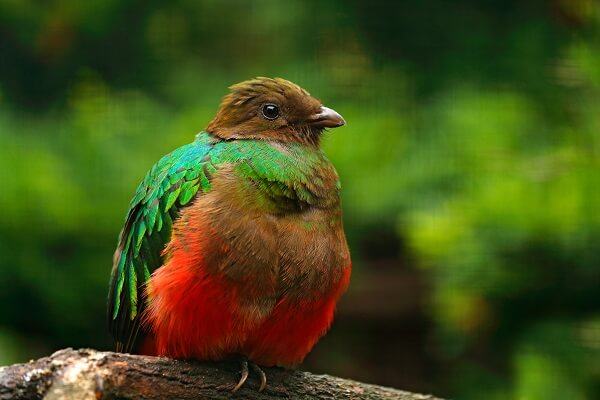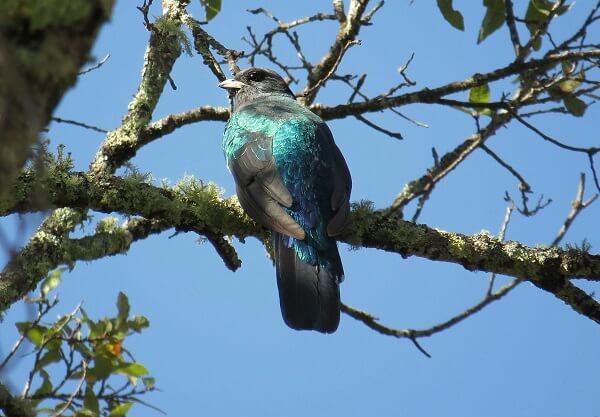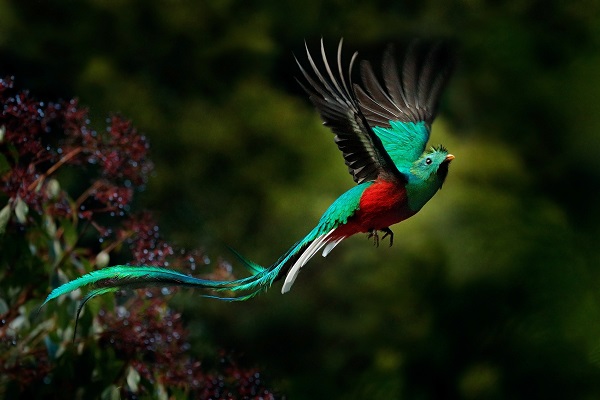
Quetzals are colorful birds that are found in the tropical forests of central and southern America, ranging from Mexico to Bolivia. There are six species of quetzal belonging to two genera; Pharomachrus and Euptilotis. These birds have green or blue metallic plumage on their bodies, with a deep red chest and belly. The males and females are similar in color, although the male is often much brighter. The female may also have brown and grey tones in her plumage. Quetzals are mostly solitary but will pair up during the breeding season. The breeding pair will make a nest in a hole in a tree close to the canopy layer of the forest. The holes may have previously belonged to other animals – like woodpeckers – or the quetzals may carve them out using their sharp beak. The female will lay two or three eggs, and the male and female will take turns incubating them. When the eggs hatch, the male and female are both responsible for feeding the young. Young quetzals learn to fly when they are three weeks old. These birds are not strong fliers, and they are rarely seen on the ground. Instead, they prefer to perch or hop about in the trees. Quetzals are crepuscular, meaning that they are usually only active during twilight hours. Quetzals are sometimes trapped to be sold as pets or for captive tourist attractions. However, the biggest threat to quetzals is deforestation and fragmentation of the tropical forests in which they live. The resplendent quetzal (Pharomachrus mocinno) is perhaps the most famous of the quetzal species. It is also known as the Guatemalan quetzal because it is the country’s national bird. It is found in Central America. The white-tipped quetzal (Pharomachrus fulgidus) is found in the Santa Maria mountains of northern Colombia and the mountain ranges of northern Venezuela. The pavonine quetzal (Pharomachrus pavoninus) is larger and chunkier than the other species. It is found in the northern region of the Amazon basin, spreading from Colombia to Bolivia. It is the only quetzal to be found in the lowland rainforest east of the Andes. The crested quetzal (Pharomachrus antisianus) is found in the subtropical and tropical montane forests in South America. This bird is found in Bolivia, Colombia, Ecuador, Peru, and Venezuela. The golden-headed quetzal (Pharomachrus auriceps) gets its name from the noticeable golden sheen on the male’s head. The males are emerald green in color, with a red belly. They also have a yellow bill. The females are less brightly colored, having more brown colors than the males. This species of quetzal is large and is known for its mournful sounding song. The eared quetzal (Euptilotis neoxenus) belongs to a different genus than the other quetzal birds. It is a large bird found in pine and pine-oak forests in the mountains of northwest Mexico. This bird can fly long distances when disturbed and has a very distinctive call. These beautiful birds have some unusual adaptations that help them to survive in their environment. Let’s take a closer look at their biology. These birds feed primarily on fruit and have several digestive adaptations that help them feed on fruit with large seeds. Unlike other birds, quetzals lack a crop – a muscular pouch where food is stored or prepared for digestion. The esophagus has a thin, elastic wall with rings of circular muscles that aid in the regurgitation of large seeds. They also have a flexible mandible and clavicle, which helps it to swallow fruit that is larger than the predicted size of their mouth. Quetzals have unusual feet which are unique to the Trogan family. These birds have four toes on each foot. The first and second toes are found on the rear of the foot, whereas the third and fourth toes are facing forward. The first and second toes are immovable. This means that their feet are feeble and make it difficult for them to be on the ground. However, their feet are perfectly adapted for perching in the trees and hopping from branch to branch! Many birds have evolved elaborate colors and decorations that are used to attract females. The quetzals are no different, and quetzal males use their tail feathers when trying to impress a female. During mating, the quetzals grow twin tail feathers that can reach up to 3 ft (1 m) in length. This is three times the average length of their body! Like many birds found in Central America, male quetzals have a mating ritual that they perform in an attempt to attract a mate. Once they have located a female they would like to mate with, they fly above her in a spiral, dangling their tail in an attempt to get her attention. The length of the tail indicates how successful a male is. The longer and more impressive the tail, the more likely the female is to mate with him.
Kingdom
Animalia
Phylum
Chordata
Class
Aves
Order
Trogoniformes
Family
Trogonidae
Genus
Pharomachrus and Euptilotis
Species
6
Niche
Frugivores
Length
13 to 16 inches ( 33 to 40 cm) long
Weight
7oz – 8 oz (200g – 225g)
Lifespan
20 – 25 years
Social Structure
Mostly solitary, sometimes found in pairs.
Conservation Status
Threatened
Preferred Habitat
Usually found in the cloud forest, close to the canopy layer
Average clutch Size
2 -3 eggs
Main Prey Species
Mostly eat fruit but known to eat insects, lizards, and other small animals.
Predators
Squirrels, owls, and hawks.
The Basics

Quetzal Species

Interesting Insights from the Quetzal!
Digestive System
Quetzal Feet

Tail Feathers
